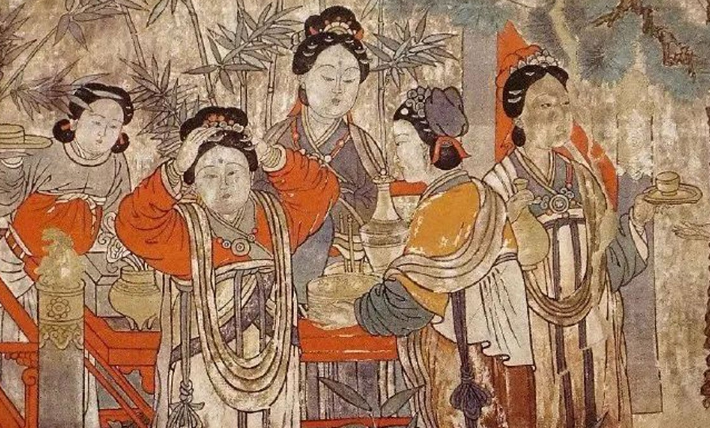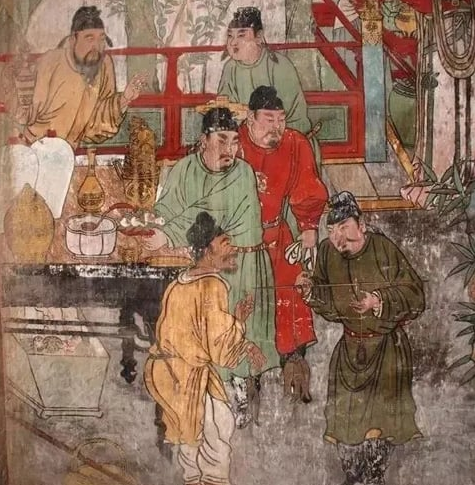The distinctive features of Hanfu in the Yuan Dynasty included Mongolian-influenced styles, heavier fabrics, and elaborate decorative elements.
Historical Context of Hanfu in the Yuan Dynasty
The Yuan Dynasty, spanning from 1271 to 1368, stands as a significant chapter in Chinese history, characterized by the Mongol Empire’s reign over China. This era, initiated by Kublai Khan’s conquests, not only altered the political landscape but also engendered a unique cultural amalgamation. This fusion profoundly influenced traditional Chinese attire, especially Hanfu, marking a departure from its earlier forms.
Overview of the Yuan Dynasty Era
The genesis of the Yuan Dynasty under Mongolian leadership marked an era of substantial cultural and trade expansion. The period fostered a thriving Silk Road, introducing new materials and ideas to China, reshaping the Hanfu with diverse influences while preserving its cultural essence. The establishment of Beijing as the capital created a cultural melting pot, catalyzing the evolution of fashion trends. This time witnessed the Hanfu transitioning, embracing novel styles and patterns reflective of a broader cultural palette.

Influence of Mongolian Rule on Chinese Fashion
The Mongolian influence ushered in a transformative era for Hanfu styles. Traditional Han garments, known for elegance and simplicity, began to integrate more ornate designs and patterns, mirroring Mongolian tastes. Bold colors and intricate embroidery, favored by the Mongolian rulers, started to feature prominently in Hanfu designs, offering a vibrant contrast to the previously muted colors. New garment types like the ‘Yuanlingshan’, a robe blending Mongolian and Han styles, emerged during this period.
This era also saw adaptations in Hanfu to accommodate the colder northern climate, typical of the Mongolian region. Heavier fabrics and layered clothing became prevalent, diverging from the lighter materials of previous dynasties. Fur trims and linings, once rare in Han Chinese fashion, gained popularity, reflecting practical adaptations to the changing environmental conditions.
The Yuan Dynasty’s social hierarchy, placing Mongols and other non-Han groups above the Han Chinese, influenced clothing regulations. Styles and colors that were once widespread became exclusive to the ruling classes, diversifying Hanfu styles and reflecting the socio-political changes of the era.
The Yuan Dynasty thus marked a period of profound transformation for Hanfu. The Mongolian influence, coupled with the dynasty’s cosmopolitan nature, introduced new materials, styles, and colors to traditional Chinese attire, leaving a lasting impact on the history of Chinese fashion. The era’s legacy in Hanfu is a testament to the enduring nature of cultural exchange and adaptation in the face of changing political landscapes.
Distinctive Features of Yuan Dynasty Hanfu
The Yuan Dynasty, a period of cultural synthesis and transformation, brought about distinctive changes in Hanfu, the traditional Chinese attire. This era, under Mongolian influence, not only reshaped the political landscape of China but also left an indelible mark on its fashion, particularly in the materials, colors, and patterns used in Hanfu.
Materials and Fabrics Used in Hanfu
During the Yuan Dynasty, Hanfu saw an evolution in the materials and fabrics used, largely due to the increased interaction with other cultures through trade. Silk, historically a staple in Chinese clothing, continued to hold prominence, but there was an introduction of heavier fabrics like wool and fur, catering to the colder climates of the north and the Mongolian preference. The use of brocade, a richly decorative woven fabric, also became more prevalent, often adorned with intricate patterns and symbols. The incorporation of these new materials into Hanfu signified a shift towards more versatile and climate-appropriate attire, reflecting the diverse influences of the era.
Colors and Patterns
The Yuan Dynasty’s Hanfu distinguished itself through its use of colors and patterns. Bright and bold colors like red, blue, and gold became more popular, deviating from the traditionally subdued color palette of earlier dynasties. These colors often held symbolic meanings; for example, red symbolized good fortune and joy, while blue represented immortality and purity. Patterns in Hanfu became more elaborate, with motifs such as dragons, phoenixes, and floral designs gaining popularity. These patterns were not mere decorations but carried significant cultural and symbolic weight. The dragon, a symbol of imperial power and strength, was a common motif in the attire of the ruling class, while floral patterns symbolized nature and the seasons.
The Yuan Dynasty’s Hanfu, with its unique blend of materials, colors, and patterns, stands as a testament to the era’s cultural diversity and innovation. This period’s influence on Chinese fashion highlights the dynamic nature of cultural exchange and adaptation, leaving a lasting legacy in the realm of traditional Chinese attire.
Styles and Designs Unique to the Era
The Yuan Dynasty heralded a new chapter in the evolution of Hanfu, the traditional Chinese attire, introducing unique styles and designs that set it apart from previous dynasties. This era, marked by Mongolian influence and a fusion of diverse cultural elements, saw significant innovations in the silhouette, decorative elements, and accessories of Hanfu.
Evolution of Hanfu Silhouettes in the Yuan Dynasty
During the Yuan Dynasty, Hanfu silhouettes underwent notable changes, adapting to the cultural and climatic demands of the time. The introduction of the ‘Yuanlingshan’, a robe with a distinctively high, crossed collar and narrow sleeves, marked a departure from the broader sleeves and lower collars typical of previous Hanfu styles. This change not only catered to the colder northern climates but also reflected the Mongolian influence on Chinese fashion. The length and layers of Hanfu saw variation, with longer robes and additional layers becoming more common, enhancing the garment’s practicality in colder weather. The silhouette of Hanfu during the Yuan Dynasty thus symbolizes the blend of practicality and cultural exchange, embodying the era’s unique aesthetic.
Decorative Elements and Accessories
The Yuan Dynasty’s Hanfu was distinguished by its elaborate decorative elements and accessories. Embroidery became a prominent feature, with intricate designs often depicting symbolic motifs such as dragons, phoenixes, and lotus flowers. These motifs were not just decorative but carried deep cultural and symbolic meanings. For instance, the dragon represented imperial authority and power, while the lotus symbolized purity and enlightenment. Accessories also played a crucial role in Hanfu ensembles. Items like jade belts, ornate headwear, and elaborate footwear complemented the richly decorated garments. These accessories were not only indicative of one’s social status but also added to the overall elegance and aesthetic appeal of the attire.
The styles and designs of Hanfu in the Yuan Dynasty stand as a testament to an era of cultural integration and innovation. The distinctive silhouettes, decorative elements, and accessories of this period’s Hanfu reflect a unique chapter in the history of Chinese fashion, showcasing the dynamic interplay of tradition, adaptation, and artistic expression.

Cultural Influences and Adaptations in Hanfu
The Yuan Dynasty, bridging the gap between traditional Chinese culture and Mongolian influences, brought about a transformative era in the world of Hanfu, the conventional Chinese attire. This period, marked by the Mongol’s control over China, saw the fusion of distinct cultural elements, profoundly shaping the styles and designs of Hanfu.
Mongolian Influence on Hanfu Styles
The Yuan Dynasty’s fashion landscape vividly reflects the Mongolian impact. A significant adaptation was the integration of Mongolian clothing styles into Hanfu. The high, crossed collars and narrow sleeves of the Yuanlingshan, a garment introduced during this era, showcased a clear departure from the traditional Hanfu designs. This change was not merely aesthetic but also symbolized the new cultural and political order under Mongolian rule. The use of heavy fabrics like wool and fur, previously uncommon in traditional Chinese attire, gained prominence, signifying the practical necessity of adapting to the colder northern climates brought about by the Mongolian influence.
Adaptations to Socio-Cultural Norms of the Yuan Era
Adaptations in Hanfu during the Yuan Dynasty also mirrored the socio-cultural norms prevalent at the time. Clothing in this era became a marker of social hierarchy and power. For instance, the use of luxurious fabrics and specific colors like red and gold, which symbolized prosperity and imperial authority, became exclusive to the Mongolian elite and the upper echelons of society. Hanfu styles evolved to accommodate the practicalities of daily life in the Yuan Dynasty. The garments were designed to be more functional, providing warmth and comfort, while still maintaining the elegance and sophistication characteristic of traditional Chinese fashion.
The influence of the Yuan Dynasty on Hanfu went beyond mere aesthetics; it represented a deep integration of cultures and a response to the changing social and environmental landscapes. This period in the history of Chinese fashion stands as a testament to the adaptability and resilience of cultural practices and traditions in the face of significant political and social changes. The legacy of the Yuan Dynasty’s influence on Hanfu continues to be a subject of fascination and study, highlighting the enduring impact of historical events on cultural expressions.







